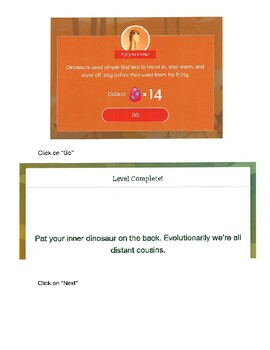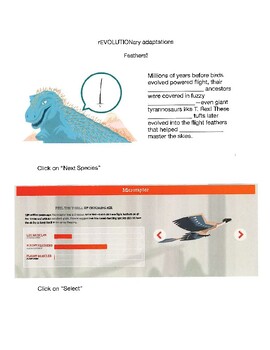Flap To The Future-Worksheet for Online Game
- PDF
- Internet Activities
Description
About Flap to the Future:
The Cornell Lab's Bird Academy created Flap to the Future to help players understand the adaptations birds evolved that help them fly. How birds evolved flight is still hotly debated by biologists and paleontologists, so what we’ve presented is a simplification of lots of fascinating scientific knowledge and questioning.
rEVOLUTIONary Adaptation: Feathers
Players start the game as Tawa, a small dinosaur that lived 200 million years ago in the floodplains of what is now the American Southwest. There is little debate among scientists that birds evolved from dinosaurs from the theropod group, like Tawa. One of the big clues connecting birds to this group of dinosaurs comes from the many impressions of simple feathers found on fossils discovered over the past few decades in China.
rEVOLUTIONary Adaptation: Flight Feathers
In Flap to the Future, players first catch some air as Microraptor. With specialized flight feathers on all four limbs, this extinct dinosaur from 120 million years ago appears to have been a gliding specialist and a tree climber. Though the flight feathers gave the dinosaur lift and helped the animal stay aloft, Microraptor did not have the flight muscles to sustain flapping flight for long distances. Some scientists have suggested that it may have been able to take off from the ground and flap for short distances. Microraptor is not a bird or even a direct ancestor of modern birds, but rather an extinct offshoot of the larger group of theropod dinosaurs.
rEVOLUTIONary Adaptation: Flapping Flight
Players first feel the freedom of flapping flight as the American Robin, a modern passerine bird, or songbird. Flapping flight is one of the hallmarks of modern birds—the only living descendants of dinosaurs—and analyses of the bird family tree suggest that even flightless species like penguins descended from a flying ancestor. The ability to fly even short distances relies on the thrust generated from flapping and the lift developed from long, stiff flight feathers. Large, well-developed breast muscles power the wing flaps, and in robins these flight muscles make up about 10% of their total body weight. Thanks to the evolution of flapping flight, robins and many modern birds have the ability to migrate thousands of miles to take advantage of food and breeding resources in far flung places throughout the year.
The Future of Flight
In the final level of Flap to the Future players explore life as a bird from the deep future. It is hard to envision what birds will be like 100 million years from now. But because evolution builds on the features that each generation inherits from its genetic relatives, we can predict that if flapping flight continues to benefit birds, it will stick around—and if not, it won't. In this level of the game, players control the strength of each of the adaptations introduced in the previous levels. This encourages players to investigate the benefits and costs of each adaptation—a process that mirrors what happens over evolutionary time.
Game Link: https://academy.allaboutbirds.org/features/flaptothefuture/





